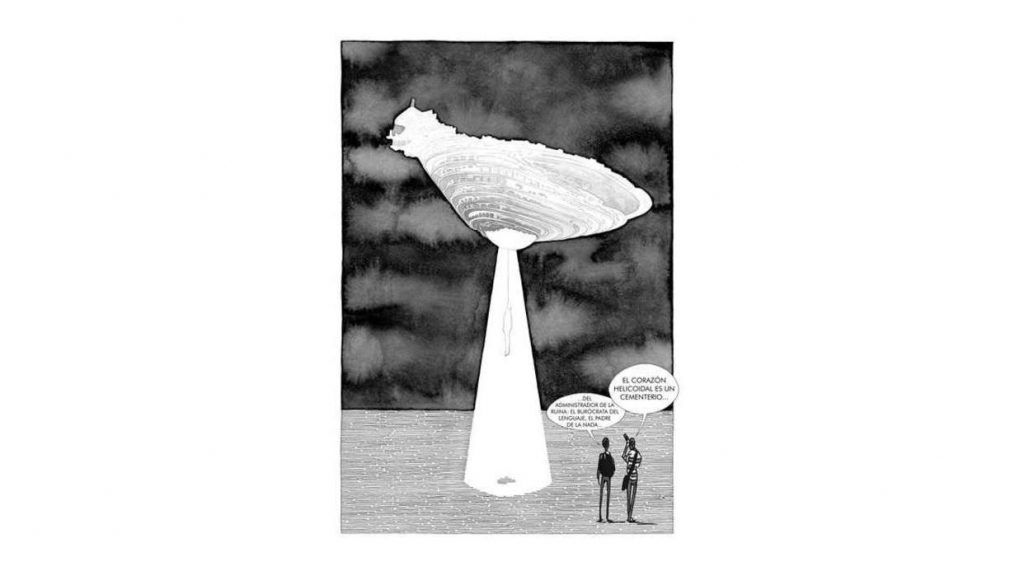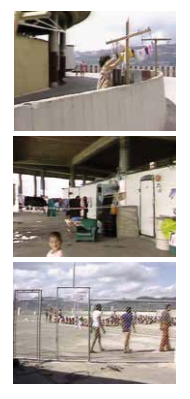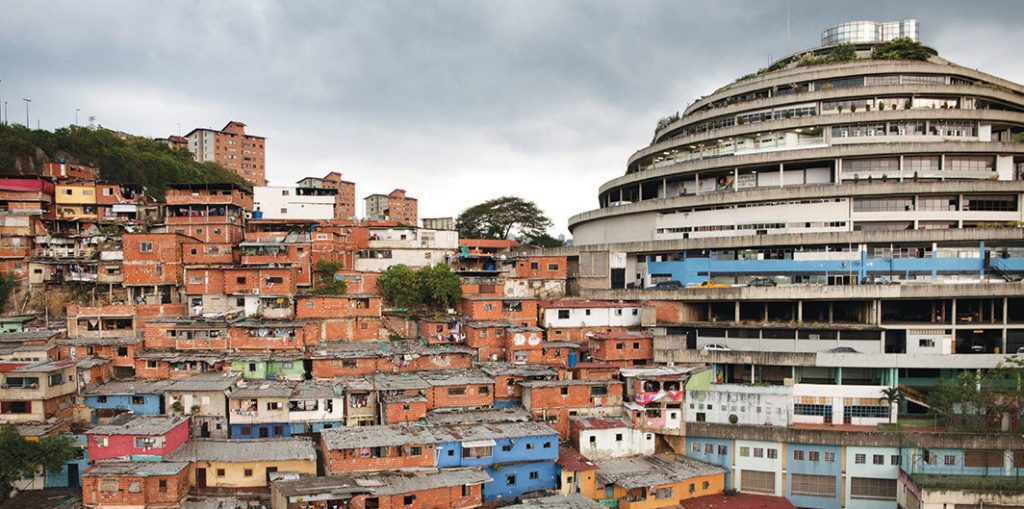By 1957, Caracas was among the most cosmopolitan urban centers in all of the Americas. The discovery of massive oil wealth in 1922 had jump-started Venezuela’s modernization, and, by the 1950s, the economy was booming. Large infrastructure projects went to famous European engineers such as Riccardo Morandi and Eugène Freyssinet. An emerging middle class decorated their homes with modern furniture from Italy and Scandinavia, and automobiles from the United States crowded the new highways. The city’s triumph also manifested in extraordinary architecture: Commissions by international luminaries such as Gio Ponti, Richard Neutra, Roberto Burle Marx, and Oscar Niemeyer dotted the country, while Venezuelan architects erected touchstones of the country’s modernism, including the seminal Ciudad Universitaria by Carlos Raúl Villanueva, Cipriano Domínguez’s multiuse Centro Simón Bolívar, and the exceptional Hotel Humboldt by Tomás José Sanabria. In 1955, the young, talented Venezuelan architect Jorge Romero Gutiérrez was asked to design a residential complex on a very difficult hilly site known as Roca Tarpeya. Rather than submit plans for a conventional apartment building, however, he proposed an audacious alternative: an elliptical drive-though shopping center with stores, restaurants, gymnasiums, and several large event spaces, to be accessed by a continuous vehicular ramp wrapping around the ziggurat-like structure—a rounded pyramid visible to the city.
For Downward Spiral: El Helicoide’s Descent from Mall to Prison, editors Celeste Olalquiaga and Lisa Blackmore have gathered twenty-eight essays on the history of this iconic structure. The contributors include architects, historians, artists, writers, critics, and curators—most of them Venezuelan—and together provide a welcome range of perspectives on Gutiérrez’s darkly fascinating building. Many writers delve into the structure’s unique history. El Helicoide de la Roca Tarpeya began as an embodiment of an optimistic vision of Venezuela’s future—one shaped by a buoyant, debtfueled economy—but it met its demise as a site of incarceration and the torture of prisoners of the state: After lying derelict for several years, and briefly housing the displaced, El Helicoide reincarnated as a notorious prison helmed by the Venezuelan intelligence service. As writer and architect Federico Vegas writes in El Helicoide of Babel, the structure “has become an enigma of uniqueness and omnipotence, and, at least on the grounds of functionality, it continues to stand as proof of gigantic and enduring errors.”
At the time of its conception, El Helicoide embodied the exuberant, streamlined values of the automobile age. In The Automobile as Generator of Architectural Form, René Davids situates El Helicoide within the visionary car-centric architecture of the era, noting that contemporary architects also drew up proposals for “superhighways flying over main arteries, parking lots suspended over rivers, and monumental buildings that placed cars at the front and center of their designs.” In fact, plans for El Helicoide were included in Roads, the “first exhibition of the art of roadbuilding,” which opened at the Museum of Modern Art in New York in 1961. Yet the construction of El Helicoide was never completed: Soon after workers broke ground, the Venezuelan economy began to contract, and the company funding the building went bankrupt in 1961, leaving the structure empty and unfinished. (Perhaps the project would have failed regardless of the economy, and the carcentric design of the spiraling strip mall– parking lot hybrid may have been its undoing: The unwieldy circulation scheme would likely have left the structure clogged with traffic.)
In 1975, the state took control of the enormous, empty, and still-unfinished building without a very clear idea of what to do with it. From 1979 to 1982, the government used El Helicoide as temporary housing for ten thousand displaced people, but the structure’s continuous ramps were not well suited to this use. In An Uneasy Cohabitation: San Agustín del Sur and El Helicoide, Diego Larrique describes El Helicoide’s deleterious effect on its neighbors during this period. Residents in the surrounding environs of San Agustín complained of foul smells and sewage flowing into the streets, and reported hearing frequent gunfire. In 1973, a state-run organization proposed converting the site into a cultural center and home for the national library. But the limits imposed by the gigantic ramp, and the interior spaces carved out of the hill, would prove too difficult and expensive to deal with for the structure to be viable for civic-institutional use. Finally, in 1985, the building was given to DiSiP, the Venezuelan intelligence and counterintelligence agency; a decade later, DiSiP began using the structure as a jail, mostly for political prisoners. Perversely, the building’s design—which remained resistant to so much—functioned well as a prison; its interior labyrinth of small spaces without natural light made effective jail cells.
THE MASSIVE CONCRETE BUILDING now looms over the city as a symbol of a failed state. In Downward Spiral, artists Ángela Bonadies and Juan José Olavarría illustrate the contrast between the idealism of the architect’s vision and the reality of a government-sanctioned palace of torture and incarceration. In a chapter from their 2017 graphic novel, Kid Heli, a flying saucer (El Helicoide turned upside down) hovers above the skyline sending a beam of light to the ground. “That belongs to the manager of the ruin, the language Bureaucrat, the father of nothingness,” observes one character, looking up at the building-cum–alien invader. Another answers, “The helicoidal heart is a cemetery.”

One of the book’s most powerful testimonies appears in Albinson Linares’s interview with the political activist Rosmit Mantilla, who was imprisoned in El Helicoide from 2014 to 2016 for allegedly financing opposition protests. (In December 2015, while incarcerated, he was elected to the National Assembly.) He describes his arrest: “Right under my eyes, one of these police officers pulled out a wad of cash from his bullet proof vest, and some leaflets about a protest march, and planted them inside my backpack.” Then, once he reached El Helicoide, he recalls, “they took me down to a cell they call «El Infiernito» (Little Hell) which measures five by three meters. There were 22 people in there, a mix of common criminals and political prisoners, all crouching on the ground. I spent eight days in that disgusting windowless cell. We had to urinate and defecate into buckets and bags, there was no ventilation, and the cell was permanently lit with bright lights.” During his time at El Helicoide, Mantilla gathered testimonies from his fellow captives, documenting a litany of tortures and abuses. Today, the political prisoners who remain continue to stage violent protests and hunger strikes (including as recently as this past July).
As accounts like Mantilla’s emphasize, the monumental pyramid is not simply a ruin but an active participant in the state’s repressive mission, and any assessment of El Helicoide as a poetic allegory for the failure of modernism, or as a work of art, must reckon with that important fact. Indeed, the state has instrumentalized the building’s very deterioration: The structure’s dysfunction aids the mission of torture and abuse, contributing to the suffering of prisoners and threatening the population at large. El Helicoide’s prominence in the urban landscape—a fact that sets it apart from most prisons—is also notable. Looming over Caracas, it transforms the city itself into a vast panopticon.


In Out of the Ashes: Building and Rebuilding the Nation, Blackmore argues that Venezuela’s past can be understood as a recurring cycle of destruction and reconstruction, beginning with the devastating Caracas earthquake of 1812, as Simón Bolívar led Venezuelans in a war of independence against Spain. Again and again, she demonstrates, one can find the “impulse to conduct nation building through the construction of dazzling architecture.” Without deeper, more structural changes to the economy and civil society, visionary buildings simply provide a momentary, mirage-like distraction— an illusion of civic wholeness. This cycle was profoundly interrupted with the election of Hugo Chavez. The impetus for Chavez’s “revolution” was destructive and not constructive. Its most urgent task was the destruction of the institutions of the democratic state and the expropriation of the free-enterprise economy.
Standing in contrast with the perverse mutation of El Helicoide into a prison is Caracas’s aforementioned Ciudad Universitaria. Villanueva’s building complex, built in the 1940s and ’50s, serves as a testament to the resilience and longevity of the architect’s original vision. Architecture, at its best, materializes a more just future, but as Downward Spiral reminds us, it can also do the opposite. El Helicoide both symbolizes the loss of Venezuela’s progressive and civic optimism and makes concrete the fear and repression propagated by a criminal state. This anthology presents the unique case of El Helicoide as a cautionary tale of the complex relationship between architecture and the society it serves.
Lea el post original en Artforum.
